This March sees the release of Batman vs. Superman. To celebrate, we’ll be looking at some iconic and modern Batman and Superman stories over the course of the month.
Mike W. Barr is one of the great Bronze Age Batman writers, a writer with a clear vision of what he expects Batman to be and with a body of work that seems build around that principle.
One of the interesting aspects of Batman is the character’s flexibility and ubiquity. Batman can be virtually anything that a writer needs him to be, and it does little to dilute the brand because there are so many other writers working on the character – often at the same instant. Even when a particular writer is working on the character, they cannot claim exclusivity. Grant Morrison’s version of the Dark Knight is distinct from Scott Snyder’s take on the Caped Crusader, for example.

Long Dark Knight of the soul…
Perhaps, as a result of this, there is more freedom for writers to craft their own unique take on Batman. Mike Barr wrote Batman across a variety of different titles over a considerable stretch of time. Barr had written random stories in Detective Comics dating back to the seventies, and had provided occasional scripts to Batman since the start of the eighties. He would continue to work sporadically on the character into the nineties and the new millennium, contributing scripts to stories like In Darkest Knight into the nineties and beyond.
However, Barr’s longest sustained work on the character came in the eighties. He wrote Batman as the headline character of Batman and the Outsiders for the first thirty-two issues of the title, collaborating with artists Jim Aparo and Alan Davis. He enjoyed a sustained run on Detective Comics with artist Alan Davis that overlapped with Frank Miller and David Mazzucchelli’s iconic Batman: Year One run. The run culminated in Batman: Year Two. He and Davis also collaborated on Full Circle. He wrote Son of the Demon and Bride of the Demon.

“Face my Wrath!”
Barr had considerable influence on the evolution of the character Batman. Grant Morrison’s creation of Damian Wayne, for example, was heavily influenced by Barr’s work on Son of the Demon. In a larger sense, Barr’s willingness to reintroduce classic Silver Age concepts into continuity following Crisis on Infinite Earths paved the way for more flexible interpretations of the Dark Knight. Barr is frequently overlooked in discussions of the character’s history, which is entirely understandable given that his most high-profile work overlapped with one of the greatest Batman stories ever told.
Still, as influential as Barr was on future depictions of the Dark Knight, it is clear that the writer had an internally consistent vision of the Caped Crusader, with a number of themes and ideas that he would visit time and time again in his work featuring the Dark Knight. Although The Player on the Other Side comes before Barr’s most extended and high-profile solo work on the character, those themes are most definitely present.

Batman Special I: The Wrath of Wrath.
Perhaps the most striking aspect of Barr’s approach to Batman is the sense of tone. Barr is a writer who has a great deal of fondness for the character’s classic Silver Age tone, arguing that a Batman comic should be fun first and foremost:
I always thought that sort of mood to the story was a vital part of Batman. I think Batman has become too grim over the years. I’m certainly not saying there’s not darkness to the man and his universe, because of his origin, primarily, but as you said in one of your columns, Batman can be a great deal of fun. And he should be a great deal of fun, especially if you bring Robin into it.
Barr began consistently writing for Batman at a time when the character was shifting, as the Bronze Age started to give way to the modern era. As noted above, Barr’s run on Detective Comics would overlap with Batman: Year One and exist in the shadow of The Dark Knight Returns.
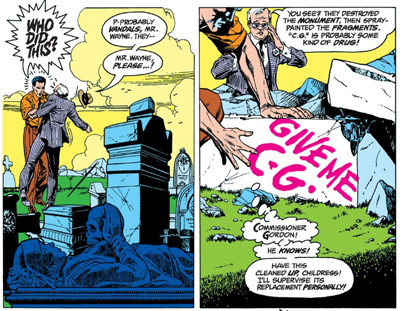
Grave danger…
The Player on the Other Side was published before this shift took place, but is of a piece with Barr’s later work. Indeed, the basic premise of the story is very consciously and unapologetically comic-book-y. The Player on the Other Side pits Batman against an evil alternate version of himself, a villain named “the Wrath” who is quite consciously and unambiguously a criminal doppelganger of the Caped Crusader. The concept is more than a little ridiculous, but the beauty of The Player on the Other Side is the way that the script just goes with it.
The title of the story comes from a speech by the English biologist Thomas Henry Huxley, espousing the importance of education. In a section of the speech, quoted by Bruce Wayne over the course of the comic, Huxley asked his audience to imagine themselves trapped in a chess game against the world itself. “The rules of the game are what we call the laws of nature. The player on the other side is hidden from us. We know his play is always fair, just, and patient… but we also know, to our cost, that he never makes a mistake — or makes the smallest allowance for ignorance.”
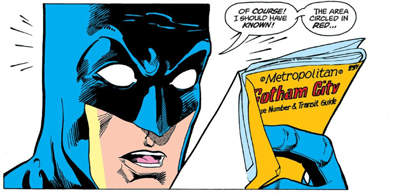
“Hn. Gotham really doesn’t have a consistent geography after all.”
Huxley was essentially arguing that a high-quality education allowed students an insight and understanding to the rules of the game that nature was playing against them. Nevertheless, the metaphor was more powerful than the thesis it supported. After all, the idea that life as a high-stakes game recurs through the popular imagination. Huxley himself referenced Friedrich Retzsch’s Die Schachspieler, a game featuring Satan and mankind locked in a heated chess battle. Bergman’s The Seventh Seal would feature its central character playing against death.
So Barr takes a fairly abstract philosophical concept of mankind’s relationship with the larger world and puts a decidedly comic book sheen on it. In The Player on the Other Side, the chess match is no longer a metaphor for the act of surviving on a day-to-day basis in potentially hostile world; it is instead a metaphor for a direct head-to-head conflict between good!Batman and evil!Batman, where evil!Batman is distinguished by the fact he is dressed in red and purple rather than blue and grey and is waging a war on law instead of a war on crime.

“Hey! That’s my bit!”
Barr frames this conflict in the most delightfully hokey manner, juxtaposing Batman and the Wrath in two introductory slash pages. The caption boxes inform the audience that “Bruce Wayne crusades against all crime, all injustice as the dread Batman… while his mirror-self wars against all law… all those who enforce the law, as… The Wrath.” There is not a lot of subtlety there, right down to the inspired design choice to have the “w” on the Wrath’s mask form his own makeshift bat ears.
There is something endearingly silly about all this, with Barr not settling for broad strokes in crafting an evil counterpart to Batman. The Wrath is not just a criminal counterpart to Batman, he is the exact mirror image. The Wrath lost his parents on the same night that Bruce Wayne was orphaned. While Thomas and Martha Wayne were upstanding citizens killed by a mugger, the Wrath was the son of petty criminals killed by an police officer. While Bruce Wayne swore to take on crime singlehandedly, the Wrath vowed to combat law enforcement.

All fired up…
Uncovering Batman’s secret identity, the Wrath reflects, “Like Siamese Twins, we were born on the same night…” The comic even suggests that there is a deeper spiritual connection between the two characters, extended beyond mere synchronicity. Towards the climax of the story, the Wrath stabs Batman only to end up burning alive. As the Wrath burns, Batman reflects that his own stab “wound hurts like fire.” Even with the death of the Wrath, the two are still connected in some abstract manner.
The Player on the Other Side is largely and unapologetically driven by comic book logic. It is easy to see why Barr has proven one of the most underrated and yet influential Batman writers. Bruce Timm and Paul Dini were clearly influenced by Year Two while working on Batman: The Mask of the Phantasm. Along with Peter Milligan, Mike Barr would have a significant influence on Grant Morrison’s work. Most obviously, Grant Morrison’s creation of Prometheus for his Justice League of America run owes a lot to the concept of the Wrath as outlined here.
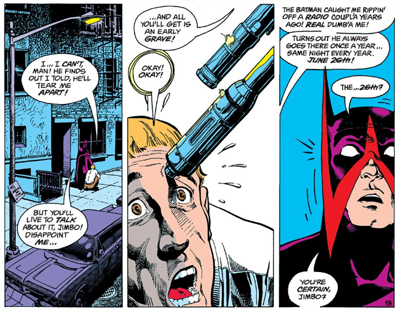
Twin town…
Although The Player on the Other Side ends with the death of the Wrath, the character has recurred from time to time. Even outside of Prometheus as something of a spiritual successor to the villain, Writer Tony Bedard and artist Rags Morales turned the Wrath into a legacy character in Wrath Child. Writer John Layman and artist Jason Fabok would resurrect the character during their underrated Detective Comics run. The Wrath is unlikely to every breakout as a true “a-list” Batman villain, but he lingers around the edge of the mythos.
Of course, it should be noted that the Wrath fills a fairly conventional vacancy within Batman’s rogue’s gallery. Batman has the best rogue’s gallery in comics, but it is interesting that there are so few evil counterparts in it. The “evil counterpart” is very much a stock comic book trope, with most heroes having at least on prominent example. Green Lantern fights Sinestro, a former Green Lantern with a yellow ring. The Flash has both Reverse-Flash and Zoom. Superman has Bizarro and the Phantom Zone prisoners.
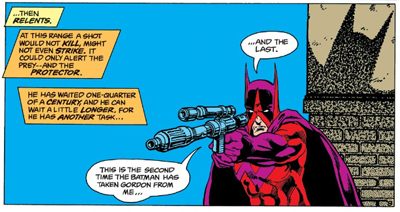
“I can kill you whenever I please, but not today.”
Most of Batman’s prominent adversaries reflect him in some way or another. The Joker is the comedian playing to the ultimate straight man. The Riddler is a source of mysteries to the world’s greatest detective. Two-Face reflects Batman’s duality back to him. Catwoman is an animal totem who reflects Batman’s moral ambiguity and line-skirting back at him. The Penguin is an aristocrat with a bird theme. However, very few of Batman’s major adversaries serve as direct evil counterparts to the Caped Crusader.
There have been a couple. Perhaps Man-Bat is the most obvious example, owing to his profile; Man-Bat was created by classic Batman artist Neal Adams and featured in On Leather Wings, the opening episode of Batman: The Animated Series. However, Man-Bat is really just a were-bat who reverses the two component words of Batman’s name. Bane his Batman’s strategic intellect, but the physical parallels are less obvious. Characters like Killer Moth and Catman have been positioned as Batman doppelgangers, but those interpretations do not last.
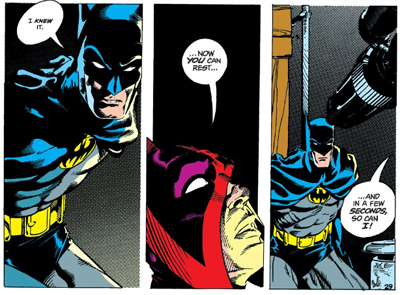
Deep purple.
Indeed, Barr himself has acknowledged that Batman has a tendency to inspire all of these evil doppelgangers, few of whom actually manage to stick around for any extended period of time:
It’s been done, as you pointed out, a number of times over the years. Every generation sort of invents the idea of an evil counterpart of a character, especially Batman, because the idea of an evil counterpart of Batman is so compelling. I wish the recent spate of Wrath sequels had had another version of the evil Batman, but I guess it’s also a tribute to Michael Golden and me.
Perhaps Barr hints at a reason why Batman has never had an evil counterpart who has endured in the same way as Bizarro or Reverse Flash. Perhaps every generation invents their own evil counterpart to Batman because every generation has their own Batman.

“What, you DON’T arbitrarily execute your henchmen?”
The Wrath is very much (and very particularly) an evil counterpart to Mike W. Barr’s take on Batman, as opposed to an evil counterpart to any larger take on the character. Indeed, despite the fact that The Player on the Other Side was written years before he would take over Detective Comics, the special hints at and foreshadows some of the key elements of Barr’s work. In particular, it serves as something of a thematic marker for Barr’s work on Year Two, foreshadowing Barr’s handling of Joe Chill by offering a funhouse mirror take on the concept.
The concept of Joe Chill is a tricky one in the larger Batman mythos. On the one hand, the character is hugely important. On the other, pinning the murder of the Waynes on a single character runs the risk of muddling Batman’s motivations. This explains why so many different writers have so many different takes on the concept. Sometimes the mugger who killed the Waynes is anonymous; sometimes he is Joe Chill. Scott Snyder tried to split the difference by making “Joe Chill” a label for such cases.
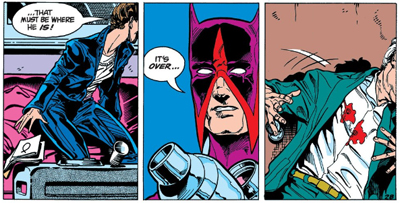
“Somehow, I never expected to win.”
Sometimes Joe Chill is caught on the night of the Wayne murders, as in Batman Begins. Sometimes Batman catches up to Joe Chill years later, as in The Untold Legend of the Batman. Sometimes Joe Chill is never caught at all. Sometimes Joe Chill becomes an even larger part of the Batman mythos, as in Batman. Sometimes Batman still obsesses over finding Joe Chill. Sometimes Batman has moved beyond his quest to find his parents’ killer and has moved on to a broader concept of justice. It varies from telling to telling, author to author.
However, Joe Chill is very important to Mike W. Barr’s conception of Batman. Indeed, Year Two marks the end of Barr’s run on Detective Comics by forcing Batman to team up with Joe Chill, working with the man who killed Bruce Wayne’s parents. One of the central questions of that story, the culmination of Barr’s run on the comic, is whether Batman could bring himself to kill Joe Chill. Barr and Davis revisit Joe Chill in Full Circle, their epilogue to the run. In that follow-up, Joe Chill’s children plot their revenge against the Dark Knight.

Packing a punch…
In some respects, The Player on the Other Side hints at all this by presenting a dark mirror of Batman who is similarly obsessed with the death of his parents. While Year Two pushes Batman into conflict with Joe Chill (as the literal representative of all crime), The Player on the Other Side positions the Wrath as a murderer targeting Jim Gordon. Barr is quite canny here, using the Wrath to set up future story threads for his Batman. The fact that Gordon is so important to the Wrath hints at how important Chill is to Batman.
(Indeed, The Player on the Other Side devotes considerable time and effort to fleshing out Bruce Wayne’s origin story. Part of that is undoubtedly to demonstrate how Batman and the Wrath ran in parallel, but it also hints at Barr’s deeper engagement with the particulars of Batman’s origin story. In fact, Barr’s script even name-drops “there is no hope in Crime Alley”, the iconic and hugely influential Denny O’Neil story that introduced Leslie Thompkins and fleshed out the importance of that location in the larger Batman mythos.)

Meeting an ally in an alley…
Quite tellingly, the Wrath is given a character arc that mirrors the classic Bronze Age tragedy of Batman, the question of whether Bruce Wayne can ever find the peace necessary to allow him to move on. The Wrath is engaged in a romantic affair with Gayle, one that consciously mirrors traditional portrayals of Bruce Wayne’s entanglements with Silver St. Cloud or Julie Madison. “He’ll be free of his obsession at last,” Gayle reflects, dialogue that might come from any Batman femme. “And we can start life over!”
How Barr chooses to portray the Wrath winds up saying a lot about how he sees Batman, which is quite a clever storytelling tool for what is essentially a pulpy “evil counterpart” story. Indeed, The Player on the Other Side serves as the perfect demonstration of Barr’s storytelling sensibilities, of the little details that make his version of Batman distinct from the version handled by other writers. Barr has a unique authorial voice, one that is internally consistent and which reflects his own interest in the character.

“For what it’s worth, you’re a much more credible threat than Killer Moth!”
Although quite removed from Barr’s most high-profile run on the title character, The Player on the Other Side makes a compelling argument for the writer’s own consistent vision of the Dark Knight. Although drowned out somewhat by the louder (and more striking) reinvention of the Caped Crusader at the hands of Frank Miller, Barr proposes his own unifying theory of the Batman. The Player on the Other Side is an introductory draft that reflects this version of Bruce Wayne through a twisted and evil doppelganger.
Filed under: Comics | Tagged: batman, evil counterpart, foreshadowing, Joe Chill, Mike W. Barr, the player on the other side, the wrath |




















Darren, have you read the New 52 Detective Comics with the new version of Wrath?
I did. I like Layman and Fabok’s run on Detective. It’s one of the underrated gems of the new 52. Although it suffers from constantly being drawn into gigantic crossovers that distract from what Layman is trying to do. And I love Fabok’s art; he was one of the stars of the Batman Eternal team, along with the underrated Nguyen.
You could argue the Joker works as the evil counterpart, Batman being serious yet heroic while the Joker is funny yet evil.
Great review. This remains one of my favorite Batman stories, particularly how it grapples with the issue of Wayne/Batman’s financial and social advantages. There but for the grace of God goes…Batman.
I can’t believe how many times you mentioned the title of the story without once referring to the Ellery Queen book of the same name. Especially since we know Mike Barr is a big mystery fan. I think one of the main reasons he liked writing Batman was that he could play up Batman’s detective abilities. He even had some short detective stories published in Ellery Queen’s Mystery Magazine. And of course, he went on to create and write The Maze Agency, one of the few true whodunnit type detective comics to be published.